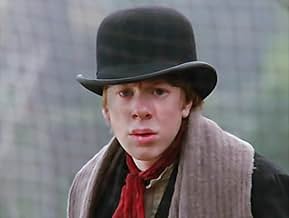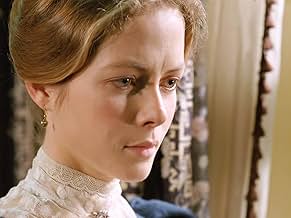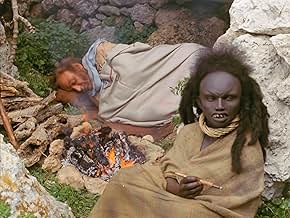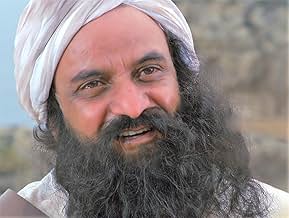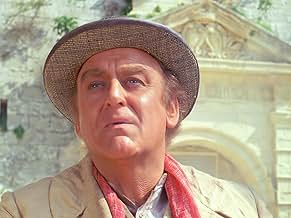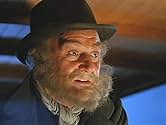CALIFICACIÓN DE IMDb
7.9/10
4.8 k
TU CALIFICACIÓN
Agrega una trama en tu idiomaThe disappearance of a young woman's father and a mysterious note years later after the strange regular annual delivery of valuable pearls to her puts Sherlock Holmes on the case.The disappearance of a young woman's father and a mysterious note years later after the strange regular annual delivery of valuable pearls to her puts Sherlock Holmes on the case.The disappearance of a young woman's father and a mysterious note years later after the strange regular annual delivery of valuable pearls to her puts Sherlock Holmes on the case.
- Dirección
- Guionistas
- Elenco
Courtney Roper-Knight
- Wiggins
- (as Courtenay Roper-Knight)
Opiniones destacadas
This is an extremely faithful adaptation of the original Doyle novel, and for purists, it can hardly be objected to (although the novel does start and end with Holmes' drug usage -- but is clearly eliminated in this adaptation, apparently by Jeremy Brett who thoroughly objected to that aspect of Doyle's character). As for the uninitiated, or general viewer, it's a bit of a slog. Brett is snappish and somewhat rude at times, unlike the Holmes of the stories, but otherwise excellent, with a gritty baritone that is quite commanding. Ronald Lacey almost steals the show as the Sholto brothers (and it's sad that he would die only a few years later). The real problem with this film is the slack editing and low key direction. Many scenes provide opportunity for dramatic punch but are handled matter-of-factly, with no help from an equally low-key music score. Also, the series of requisite backstories presented in the novel is too much for the film, getting to a point where we're even given a flashback-within-a-flashback. And to top it off, the climax of the story is yet another backstory flashback. It IS Doyle and it IS faithful, so you can't complain that the filmmakers took liberties and fouled things up... but the weakness of the novel as film material is also exposed. Purists though, should be delighted.
This version of "The Sign of Four" is the closest anyone has come to transferring the spirit and letter of Doyle's stories to film. And it stars what might be the best Holmes and Watson to ever appear onscreen, Jeremy Brett and Edward Hardwicke. "The Sign of Four" is a very close adaptation of Conan Doyle's novel, but that would count for nothing if it wasn't stylishly directed, sumptuously produced, and perfectly acted.
It was also made at the right time, when the Granada Sherlock Holmes TV series had proven a success and received the go-ahead and financial backing to expand its format. "The Sign of Four" was filmed in 35mm with a lavish (for TV) budget and presents a convincing vision of Holmes's world, from the cluttered Victorian furnishings to a steam launch chase down the Thames. Jeremy Brett was at the peak of his powers, before manic depression and heart failure permanently wrecked his health. His mercurial Holmes lives only for detection--without a case he's twitchy and irritable; on the trail he suave and scintillating. Hardwicke's Watson is grizzled paragon of common sense and decency. The other players (Jenny Seagrove, John Thaw, Ronald Lacey) are a perfectly cast assortment of eccentrics.
Director Peter Hammond is over-fond of compositions involving mirrors, but he keeps the eye (and the actors) occupied. At its best the film is a catalogue of quintessential Sherlockiana: London fog, hidden treasure, the Baker Street Irregulars, and Holmes's outlandish disguises, violin playing, and elaborate deductions. The plot is classically Holmesian, involving Imperial misdeeds coming home to haunt their perpetrators. Some have criticized the film for the lengthy flashback near the end, but this is the emotional heart of the film, the why-done-it that comes after the criminal's apprehension and gives a tragic coloring to his crimes. It gives the literal Sign of Four an ethical resonance.
Like all of the Granada Holmes productions, "The Sign of Four" has been remastered and released on Blu-Ray. It looks great but whoever handled the color correction eliminated the day-for-night effects so many scenes are brighter then they should be.
It was also made at the right time, when the Granada Sherlock Holmes TV series had proven a success and received the go-ahead and financial backing to expand its format. "The Sign of Four" was filmed in 35mm with a lavish (for TV) budget and presents a convincing vision of Holmes's world, from the cluttered Victorian furnishings to a steam launch chase down the Thames. Jeremy Brett was at the peak of his powers, before manic depression and heart failure permanently wrecked his health. His mercurial Holmes lives only for detection--without a case he's twitchy and irritable; on the trail he suave and scintillating. Hardwicke's Watson is grizzled paragon of common sense and decency. The other players (Jenny Seagrove, John Thaw, Ronald Lacey) are a perfectly cast assortment of eccentrics.
Director Peter Hammond is over-fond of compositions involving mirrors, but he keeps the eye (and the actors) occupied. At its best the film is a catalogue of quintessential Sherlockiana: London fog, hidden treasure, the Baker Street Irregulars, and Holmes's outlandish disguises, violin playing, and elaborate deductions. The plot is classically Holmesian, involving Imperial misdeeds coming home to haunt their perpetrators. Some have criticized the film for the lengthy flashback near the end, but this is the emotional heart of the film, the why-done-it that comes after the criminal's apprehension and gives a tragic coloring to his crimes. It gives the literal Sign of Four an ethical resonance.
Like all of the Granada Holmes productions, "The Sign of Four" has been remastered and released on Blu-Ray. It looks great but whoever handled the color correction eliminated the day-for-night effects so many scenes are brighter then they should be.
Sherlock Holmes is a brilliant crime series, and has a brilliant star in the name of Jeremy Brett, who was without doubt the best Sherlock Holmes.
What is excellent about this adaptation, is the closeness to the book, and of course the acting of Brett and Hardwicke. And the fine camera work and period detail. Jenny Seagrove and Ronald Lacey did very well in their roles.
But for me, the highlight was the boat on the river chase, and the introduction of Jonathan Small(the flashback sequences were very interesting and beautifully played too), who was brilliantly played by the late John Thaw. He was the best actor in the adaptation, apart from Brett. It must be really uncomfortable with a wooden leg though. Great music too, very haunting at the beginning especially.
This is really good, if a little creepy, Tonga was very scary. The Ian Richardson version is also good, but not as effective. 9/10 Bethany cox
What is excellent about this adaptation, is the closeness to the book, and of course the acting of Brett and Hardwicke. And the fine camera work and period detail. Jenny Seagrove and Ronald Lacey did very well in their roles.
But for me, the highlight was the boat on the river chase, and the introduction of Jonathan Small(the flashback sequences were very interesting and beautifully played too), who was brilliantly played by the late John Thaw. He was the best actor in the adaptation, apart from Brett. It must be really uncomfortable with a wooden leg though. Great music too, very haunting at the beginning especially.
This is really good, if a little creepy, Tonga was very scary. The Ian Richardson version is also good, but not as effective. 9/10 Bethany cox
One of Conan Doyle's best Holmes stories is adapted to perfection in this, the first feature length Holmes adventure from Granada Television. Jeremy Brett and Edward Hardwicke are fantastic (as always) and the supporting cast are quite good, not to mention appropriately quirky (especially important in this adventure).
The adaptation itself is, as was typical with the Granada series (and at least the first two feature length outings), quite faithful to the original story. It's well crafted and beautifully directed, with all the twists and turns of the Conan Doyle original (one of his most remarkable tales).
In short, this version of The Sign of Four manages to outshine all previous adaptations, and hasn't been rivaled since. The 1983 television version with Ian Richardson was certainly passable, but doesn't come close to this. Once again, Granada prove that their Holmes is without equal.
The adaptation itself is, as was typical with the Granada series (and at least the first two feature length outings), quite faithful to the original story. It's well crafted and beautifully directed, with all the twists and turns of the Conan Doyle original (one of his most remarkable tales).
In short, this version of The Sign of Four manages to outshine all previous adaptations, and hasn't been rivaled since. The 1983 television version with Ian Richardson was certainly passable, but doesn't come close to this. Once again, Granada prove that their Holmes is without equal.
JEREMY BRETT and EDWARD HARDWICKE head the cast of an excellent version of THE SIGN OF THE FOUR, given fine support by JENNY SEAGROVE, RONALD LACEY and JOHN THAW.
The intricate story begins with a young woman (Jenny Seagrove) coming to Holmes with a story involving the mysterious disappearance of her father. Several years after his death she began receiving yearly presents of priceless pearls, one by one each year. The story becomes more and more complex as more of the characters involved in her father's disappearance come to the fore. Among them, RONALD LACEY, who gives a quirky performance as twin brothers whose father wanted them to receive his inheritance. JENNY SEAGROVE and JOHN THAW are particularly interesting in well-defined supporting roles.
All the Victorian atmosphere is here along with elaborate settings and fine color photography. The two hours go by swiftly, since there's so much story to tell. Well worth watching with only a few scenes toward the end that seem to go on too long.
The intricate story begins with a young woman (Jenny Seagrove) coming to Holmes with a story involving the mysterious disappearance of her father. Several years after his death she began receiving yearly presents of priceless pearls, one by one each year. The story becomes more and more complex as more of the characters involved in her father's disappearance come to the fore. Among them, RONALD LACEY, who gives a quirky performance as twin brothers whose father wanted them to receive his inheritance. JENNY SEAGROVE and JOHN THAW are particularly interesting in well-defined supporting roles.
All the Victorian atmosphere is here along with elaborate settings and fine color photography. The two hours go by swiftly, since there's so much story to tell. Well worth watching with only a few scenes toward the end that seem to go on too long.
¿Sabías que…?
- TriviaThe first episode filmed after Jeremy Brett began treatment for bipolar disorder.
- ErroresWhen getting into the police launch, Holmes and Watson pass the statue of Boadicea outside Parliament. The statue was not erected until 1902, well after the story is set.
- Citas
[last lines]
Dr. John Watson: What a very attractive woman.
Sherlock Holmes: Was she? I hadn't noticed.
- ConexionesFeatured in Timeshift: A Study in Sherlock (2005)
Selecciones populares
Inicia sesión para calificar y agrega a la lista de videos para obtener recomendaciones personalizadas
Detalles
- Fecha de lanzamiento
- País de origen
- Idioma
- También se conoce como
- Sherlock Holmes: The Sign of Four
- Locaciones de filmación
- Productora
- Ver más créditos de la compañía en IMDbPro
Contribuir a esta página
Sugiere una edición o agrega el contenido que falta

Principales brechas de datos
By what name was The Sign of Four (1987) officially released in Canada in English?
Responda

